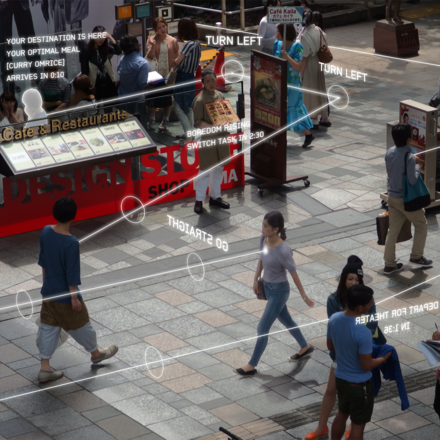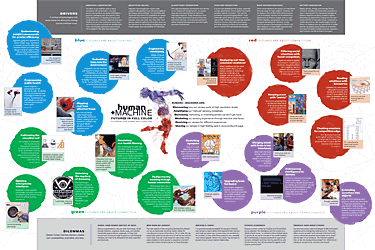Future Now
The IFTF Blog
The Blue City: A Human+Machine Futures Scenario
If you paused and observed, you could almost make out the invisible hand guiding people on their hurried but merry marches around the city. The system doesn’t like dawdlers and certainly doesn’t allow pausing long enough to actually observe the system in action. Within a few moments, your auditory cone would fill with irritating noise. You might receive an olfactory-gram from the corner bakery, inducing an intense craving for something sweet. And if you managed to resist those attempts at mobile persuasion, the solar sidewalk beneath your feet would begin to heat to an uncomfortable temperature. If the system wanted you to move, you were going to move eventually, but of course it would always be your choice.

Life in the city is smooth—you almost never feel the system working. The individual is sacred, at least that’s what the great corporate paeans to choice assert. And messages reminding you of your right to choice are constantly generated and splashed across both physical and virtual space by the government’s newest narrative algorithm. Even with its incessant flow of brainwave readings, the system always protects individual free will, and it makes a persuasive case.
Engineered for seamless living
It’s as if the city is designed for you. A self-driving car always appears when you need it, one that automatically routes you where you need to go and emits calming eucalyptus on particularly busy days. In the evenings, your Navigator shoes lead you to the subway, the long day of work fleeing from memory as you watch each passenger’s mood-illuminated clothes magically fade into matching shades with each stop—not thinking about your own transformation to complement the whole. You often run into friends for an impromptu dinner at the neighborhood restaurant, so happy for an unplanned outing that you don’t notice your EyeHealth contacts obscuring desserts from the menu. Between courses, sweeping music suddenly plays when a potential mate with complementary DNA and disposition passes by— music only the two of you can hear.
…Yet is it the life you want to live?
Your habits and little behavioral quirks always converge with those of others. The system’s reminders are so good, and so subtle, you forget they’re even there. Like a knife in the hand of an expert chef, the little pings and pokes from the things on your body are a natural extension as the line between you and the rest of the world—between human and machine—blurs. Yet sometimes you wonder if it’s possible to experience a moment outside the system, to rise above the people, goods, and information constantly on the move and see the mysterious central-control map your mother says is just an urban legend. These thoughts are only fleeting, but you entertain them more and more. That sharp pain rising from your neural-networked shoe hurts only for a second when you do.
A scenario about control in human+machine futures
 This scenario is one of the four possibilities we imagined in our new map, Human+Machine Futures in Full Color: Extending Our Senses and Ourselves, the first in our 2015 Technology Horizons program’s series of projects about Human+Machine Futures—the blurring lines between human and machine, natural and artificial. The map forecasts how emerging technology is creating what are today vast and unknown territories of human sensory experience. Rooted in the color-based systems mythology tool IFTF developed in 2014, we intended for the map’s forecasts, scenarios, and artifacts from the future to help us imagine how the future of human-machine symbiosis will be colored by our priorities, concerns, and values.
This scenario is one of the four possibilities we imagined in our new map, Human+Machine Futures in Full Color: Extending Our Senses and Ourselves, the first in our 2015 Technology Horizons program’s series of projects about Human+Machine Futures—the blurring lines between human and machine, natural and artificial. The map forecasts how emerging technology is creating what are today vast and unknown territories of human sensory experience. Rooted in the color-based systems mythology tool IFTF developed in 2014, we intended for the map’s forecasts, scenarios, and artifacts from the future to help us imagine how the future of human-machine symbiosis will be colored by our priorities, concerns, and values.
This blue scenario and artifact from the future are about control and efficiency—a subtle and seamless engineering of the lived experiences of both humans and machines. We can see the blue color archetype's focus on control in the Blue City's clean, clear, and logical interface. The goal of this system is as “blue” as its interface; the whole point of all its routing and coordination is to create order from complexity to ensure efficiency for urban residents, even if it means we might give up a bit agency here and there.
Signals of this blue future from today
While the technologies we see in the scenario mostly do not exist in those forms or are not currently so interconnected, we found signals from today that point to the possibility for elements of the blue scenario to emerge in the next decade.
- SuperShoes, a design prototype by Dhairya Dand, are smart insoles that integrate with mapping software on the wearer’s smartphone and give directions by “tickling” their toes to indicate where to turn. They even learn the wearer’s patterns to suggest nearby shops or parks the wearer might enjoy. The artist wanted to enable urban rediscovery by providing information we need without having to look down at our phones. This points to the capacity and desire to design interfaces that engage senses other than hearing and vision to offer cues about the world around us. A “blue” usage of this kind of technology would leverage its efficiency, ease, and subtlety to design interfaces that tap into the optimal sensory experience, one that achieves the system's end without necessarily drawing attention to the means.
- MIT Media Lab’s AutoEmotive initiative is developing a car that senses a driver’s stress, distraction, or tiredness and adjusts sensory parameters such as music volume and headlight brightness to promote awake and aware driving. The prototype is designed to influence driver behavior without drawing particular attention to itself, very much a blue technology. It could even aggregate cars to track the collective mood of drivers during evening traffic, very much a blue city technology. But this also raises some important questions about agency in the human-machine relationship. Granted, our environments already have substantial influence over our behavior and even our self-identity, and entities from governments to retailers design spaces to entice certain behaviors. In fact, we could say these are where we see “blue” designs today. But when sensory technology becomes more powerful, pervasive, and dynamic, we could see such efforts supercharged.
- How far could this go? Sensory Fiction points to some potential answers. The prototype is a “wearable book" vest that swells, contracts, vibrates, heats up, or cools down to provide an immersive storytelling experience tailored to the reader. It uses a number of sensory cues to evoke a range of emotions in the reader as the story progresses. This particular application of such tech might seem relatively uncontroversial, but imagine in a decade that we have clothing with this capacity on our bodies more often than not. A “blue” usage of this technology would be to manipulate our emotions, or communicate them to others, to make our social interactions, work, and other aspects of life smooth.
What is the color of the future you want to design?
The extremes of these signals might be uncomfortable, especially when put together, in a blue future. But how would a “red” approach, which creates winners and losers, use this technology? Might a “green” approach, which prioritizes connection, seem more natural? These are the kinds of questions we designed these scenarios to provoke. Over the next several weeks, we’ll post the other three scenarios and artifacts, painting a picture of the full color spectrum of emerging technologies shaping the human-machine relationship, in the hopes that it helps you design for the future in which you’d like to live.

This post is from our 2015 forecast map, Humans+Machine Futures in Full Color: Extending Our Senses and Ourselves, which explores how advances in technology will create new forms of human-machine symbiosis, expanding and even redefining what we can do with our five senses.
Also see:
Curious about the Technology Horizons program?
- Follow the forecasts at @iftf
- Find out more about the program
- Check out previous years' Technology Horizons research
- Contact Sean Ness ([email protected])



